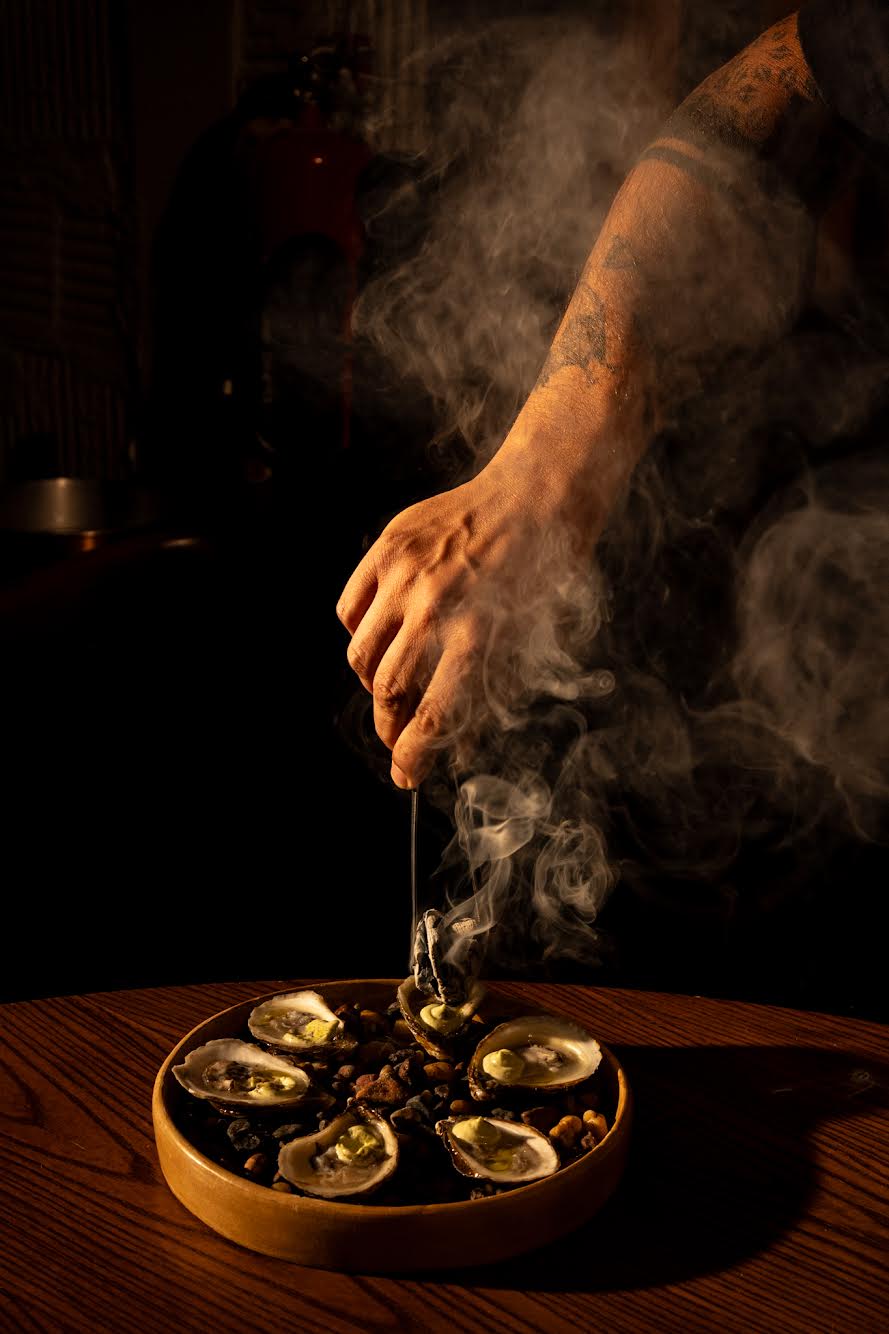
What To Order This Summer at Palo Santo, Atlanta’s Temple to Mexican Fine Dining
It’s been 18 months since Palo Santo opened its doors in West Midtown, yet the restaurant has already made an impact on a city that’s craved high-end Latin cuisine for quite some time. A Mexico City-born chef, Santiago Gomez exudes a warmth that almost takes you by surprise, especially as a man of few words. He’s constantly looking for ways to improve, tweaking the menu even if ever so slightly, every couple of weeks or so. Creativity, originality, progress — not perfection — is what comes to mind.
A frequent traveler who draws inspiration from places like Mexico, Miami, and Japan, Gomez has amassed decades of experience in restaurants like Nobu and Miami’s celebrated Cantina La Veinte before coming to Atlanta to make his mark. The sweet spot for him is in the marriage of Mexican products from organizations like the Mexican social enterprise Tamoa with local Georgia goods and produce, from towns like Carlton, Ellijay, and Buchanan.
“Recently, we got beautiful strawberries, which we are fermenting to make salsa. This week, we’ll have scallions and see which dishes we can use them in,” Gomez says. Tortillas are crafted by hand in-house daily: “We source heirloom corn for our tortillas and various corn-based dishes, alongside heirloom beans and cacao, among other ingredients, from Tamoa.”
The constantly evolving menu is unlike any other in Atlanta, drawing inspiration from Mexican ingredients, wood, charcoal, and global flavors, while keeping seasonality at the forefront. New menu additions are seafood focused, almost Spanish in nature, but Gomez likes to keep diners guessing. “Mexican ingredients form the foundation of our culinary repertoire,” says Gomez.
In this edition of Dish by Dish, whether you’re a regular or visiting for the first time, here’s what to order.


Mussels and Bone Marrow Toast
With brûléed bone marrow and chipotle beurre blanc on crunchy, toasted sourdough, these mussels melt in your mouth. The Atlanta-based Zaken Bread supplies Palo Santo’s 18-year-old sourdough starter. “He’s a good friend who makes bread in his house just for us, but hopefully he’ll open his bakery soon,” says Gomez.
Deme Embered Oysters
Charred tableside in the moody, flatteringly lit dining room, these yuzu and serrano mayo oysters are inspired by Gomez’s long-time friend and Barcelona native Deme Lomas of Niu Kitchen, who has a ponzu and rice vinegar mayo version on his downtown Miami menu. Smoky and cool (we’re talking temperature here, but the tableside experience is in fact also very cool), the oysters are presented as a half-dozen — umami, tangy, light, and the perfect portion size to start your meal.
Fluke Ceviche
Another fresh and light dish to open a meal with is the restaurant’s delicately flavored fluke ceviche. Featuring dried chipotle leche de tigre, grilled sweet corn, shallots, ginger, garlic, and confit celery, this Peruvian-Mexican dish is sweet, but also has a hint of spice. As with most courses at the restaurant, Gomez adds a touch of smoke to this one with grilled cancha (Peruvian corn nuts) and finishes it off with fresh avocado.
You may get the urge to drink what’s left at the bottom of the bowl or use it as a dipping sauce for that sourdough we mentioned above. But the level of hospitality is truly what sets a restaurant like Palo Santo apart, so chances are bread and steaming tortillas will continue to appear before you can even ask for them.


Shrimp Kebab al Pastor
New for the summer, this dish uses cilantro flowers from the restaurant’s partnership with Bremen Farms, and the shrimp is roasted on a skewer, directly over wood fire. Impeccably seasoned, what really makes this kebab irresistible is the pineapple brown butter made with fresh pineapple juice — it’s the kind of condiment that would lift any dish, whether slathered on pancakes, biscuits, steak — but here, the pairing with juicy shrimp is a natural partnership.
Grass-Fed Lamb Barbacoa
By the time the lamb barbacoa comes around, it’s likely you won’t have much room left. Accompanied by celery root purée and fresh herbs, the lamb barbacoa at Palo Santo is marinated for 24 hours in adobo before being cooked over the woodfire grill. Gomez buys agave leaves at Buford Farmers Market, burns them, then slow-cooks them for hours before the dish is ready to serve. But despite the lamb’s star billing, the celery stalk purée is the understated MVP, offsetting the heft of the meat. Scoop it up like mashed potatoes — sweet and nutty with a natural earthiness and salinity, it’s a perfectly creamy and comforting accompaniment.
Lobster Fideo Seco
Comprising smoked thin noodles (like vermicelli in ingredients and shape), buttery grilled lobster chunks, and a tangy lemon hollandaise, a current iteration of the fideo at Palo Santo uses purple kohlrabi from Hickory Farms in addition to crunchy watermelon radish.
While Mexican fideos are usually presented as a soup, this one resembles the Catalan version, which is savory, drier, and crispier — not unlike a paella, minus the rice. Using a family recipe Gomez’s mom made for him as a child, he now makes it the same way for his daughter at home. A favorite item on the menu right now, the fideo is a dish you won’t get sick of even if you eat it every day — you can really taste the love.


Burnt Cheesecake
The Basque burnt cheesecake has seen many renditions worldwide since it was created at La Viña, a small family-run restaurant in San Sebastián in the late 1980s. The most basic version of this dessert contains five ingredients, and while there’s no graham cracker crust (as is typical of many American cheesecakes), instead the cake is cooked at much higher temperatures in order for the top and pan edges to form a natural shell. The insides remain bouncy and creamy, similar to a flan.
At Palo Santo, Gomez wanted to give this cheesecake a Mexican spin with a jam made from preserved tomatillo, which is commonly used to make salsas. Less sweet than your typical Basque cheesecake, the cream cheese center oozes out of each slice, almost like a melted brie, while the tart tomatillo is an unexpected but welcome pairing.


But wait, there are cocktails!
Like many ambitious restaurants, plenty of thought has been given to the beverage program at Palo Santo. Plump for OGs like the Santo Carajillo with Nixta and rum, or the traditional Licor 43 and espresso. The latter pairs perfectly with the cheesecake and arrives at the table in a smoking moka pot that adds a sweet fragrance to the air. Meanwhile, the Tres en Uno is reminiscent of pressed carrot-orange juice but fortified with tequila and mezcal, topped with a beet cracker.
New cocktail list additions are fresh, tropical, and offer welcome relief to the rising summer temperatures in Atlanta. Two standouts are the Fresita 20, a blend of Don Julio 70 Cristalino, St. Germain, strawberry, lime, and hibiscus salt; and the Mango Colada, crafted with Uruapan Charanda rum, Las Californias gin (made with botanicals from both Mexico and the US), Kalani Coconut Liqueur (fresh coconut milk fermented and macerated in Mexican rum), smoked pineapple, mango, and lime.
And let’s not forget the rolling spirits cart…
Pushed through the dining room by servers throughout the evening, a cart filled with premium and small-batch tequilas and mezcals allows diners to pick their poison — and by poison, we just mean agave worms, crickets, scorpions, and other garnishes like lemon, lime, and salt. In the past, the cart has held offerings like Casa Dragones Tequila and Mezcal Los Siete Misterios. “Now, we are featuring sotol, which is distilled from wild plants, mainly from Chihuahua,” Gomez says. “And a new addition is the Clase Azul mezcal made with green agave from San Luis Potosí.”
While beverage director Antonio Morales’ focus is spirits, he knows all about food, too. On a recent visit, he offered us restaurant suggestions for an upcoming Mexico trip after delivering a shot of raicilla (a floral and green-tasting agave-based spirit from Jalisco) paired with orange slices and crushed worm salt to the table — he is the nephew of a famous Mexico City chef, after all.
Morales says that patrons of the restaurant are open to trying new things and are excited about the natural education that comes with ordering from the cart. So if you want to learn the differences between bacanora, raicilla, sotol, mezcal, and tequila (where they come from, what they are made of, etc.) — just ask for Antonio.
Palo Santo is open for dinner Tuesday to Sunday from 5.30 to 11 p.m. Grab your spot here.
Allison Ramirez is a bicoastal, Atlanta-based (for now) freelance journalist. She has over a decade of experience writing for publications like Travel + Leisure, the Daily Beast, Liquor, Thrillist, and others. Her recent work spans art, architecture, travel, and food & beverage stories, focusing on diversity within those spaces in the South and beyond. Follow her on Instagram here. Follow Resy, too.
Discover More

Stephen Satterfield's Corner Table




















